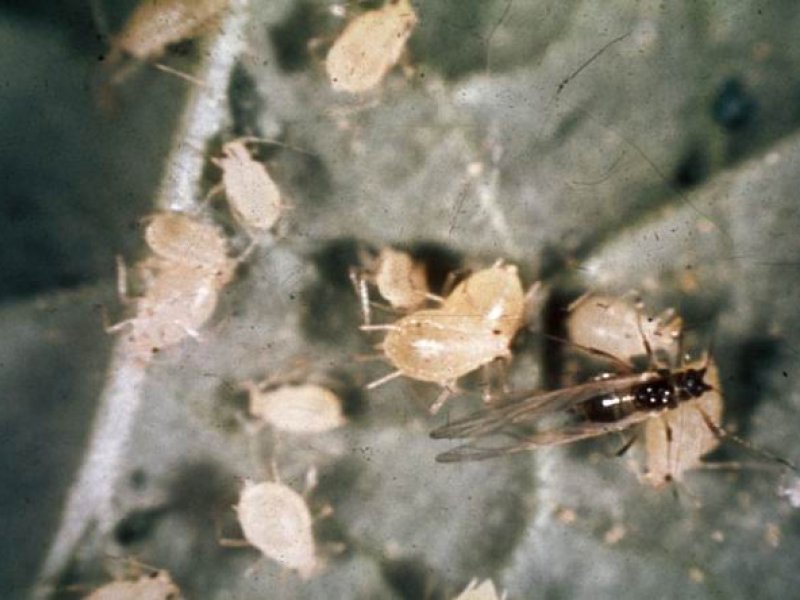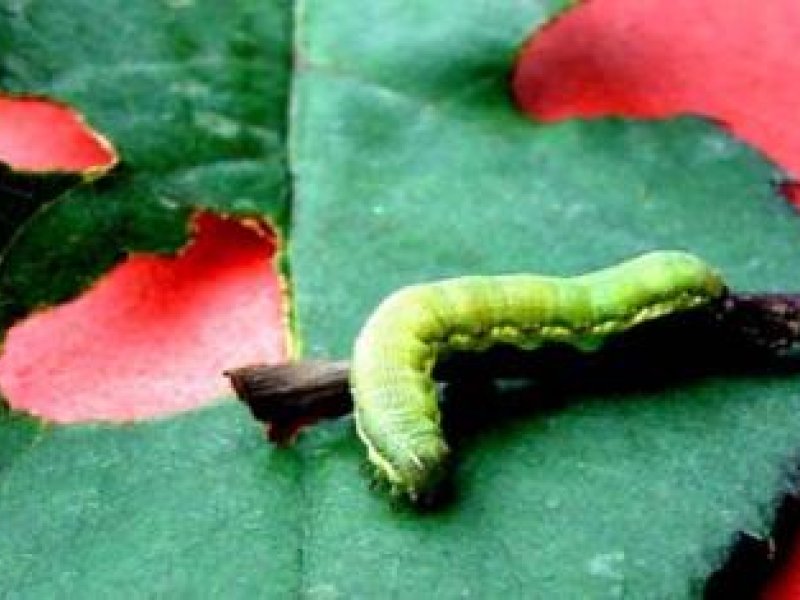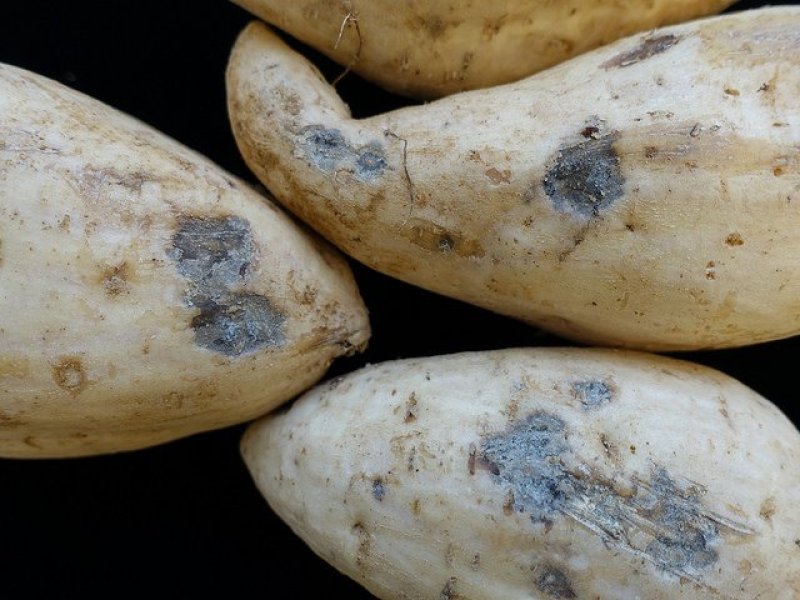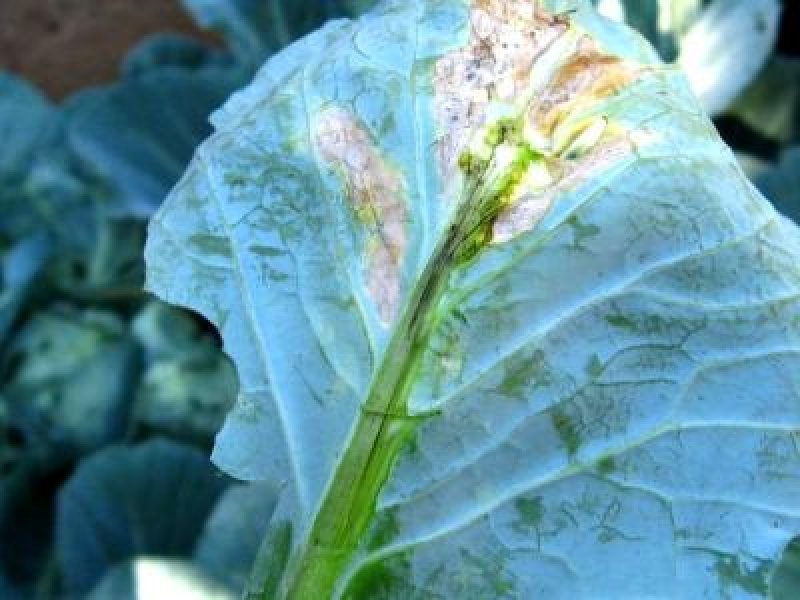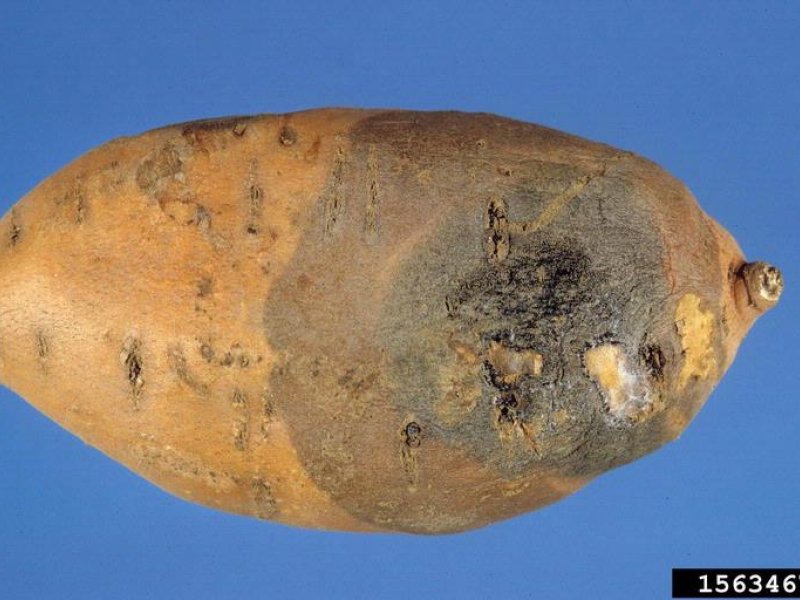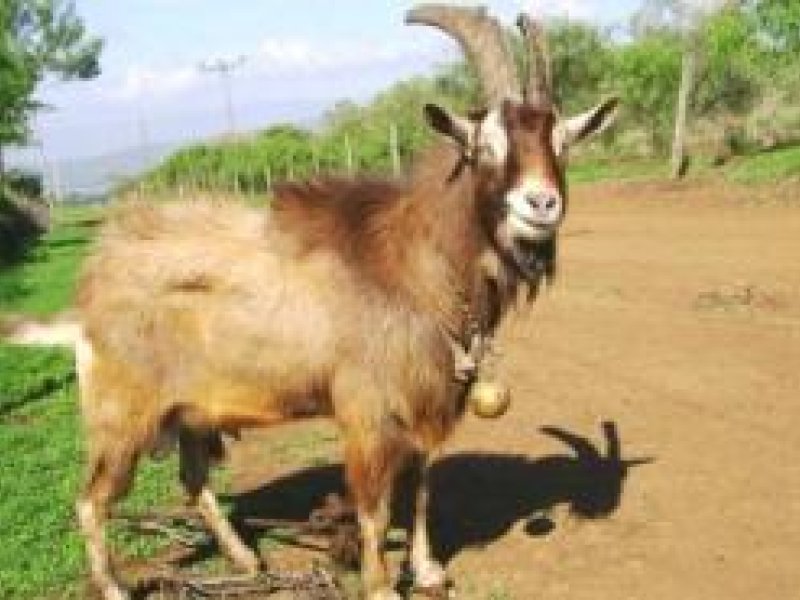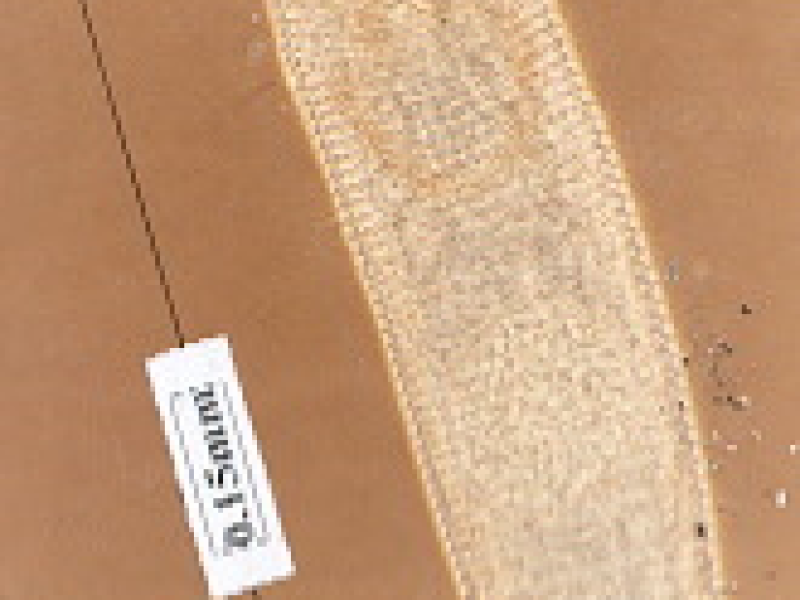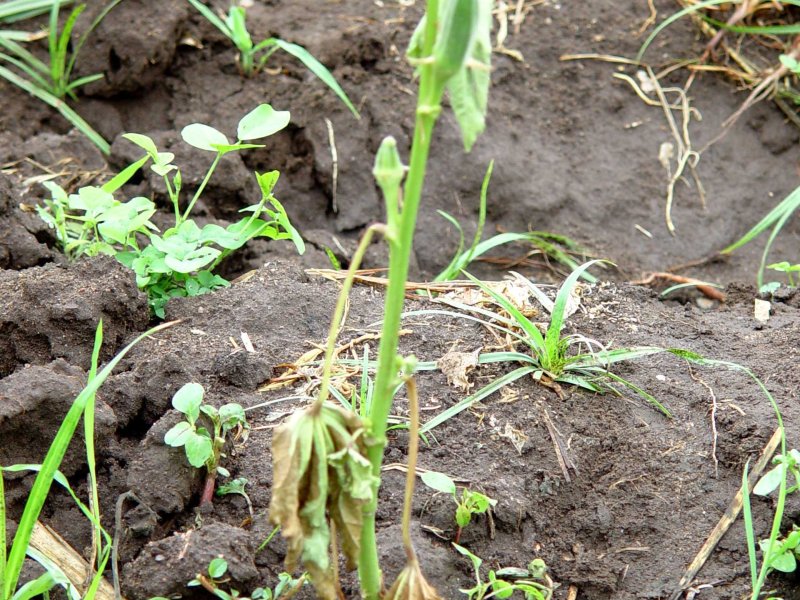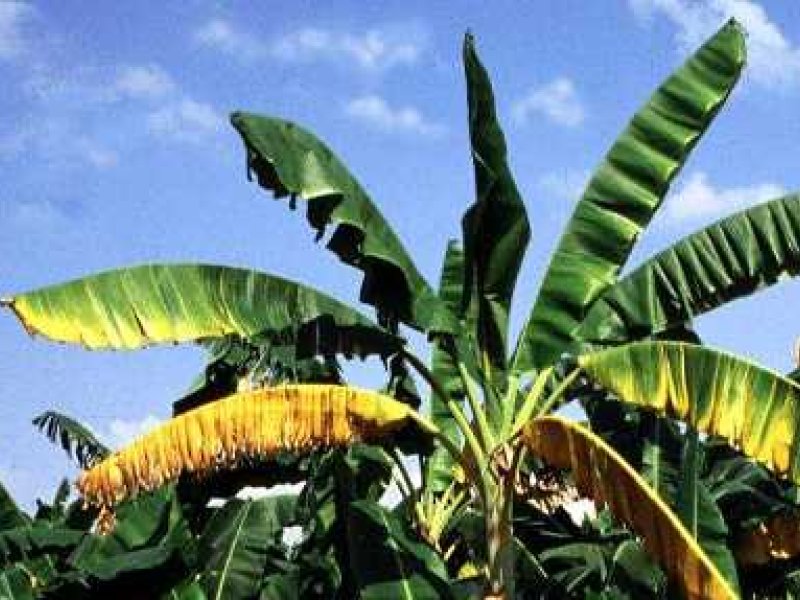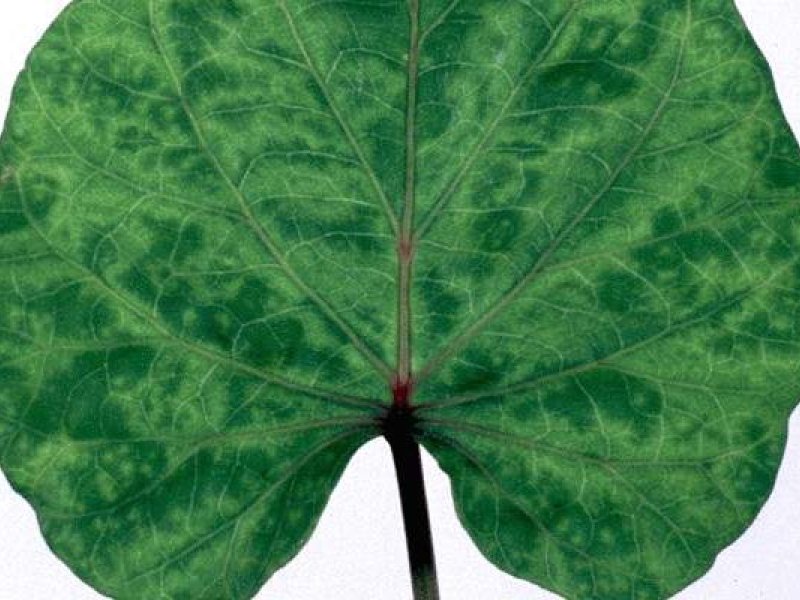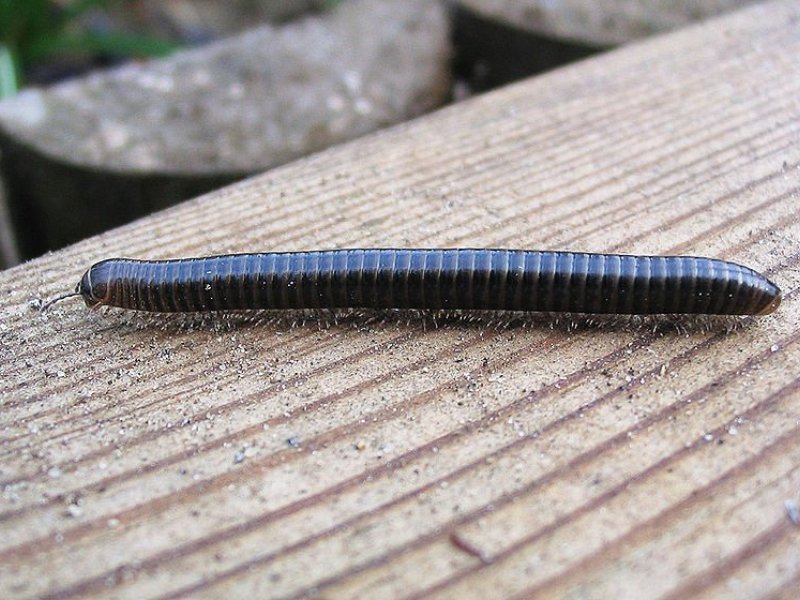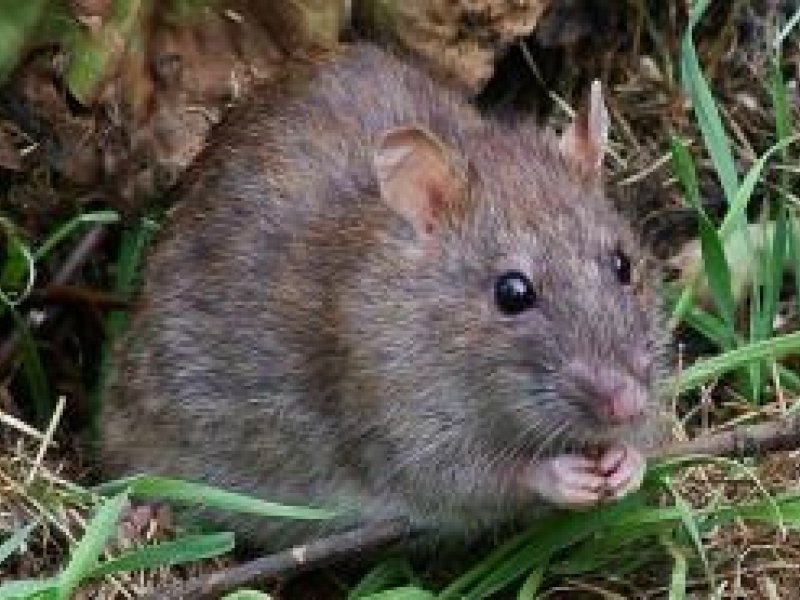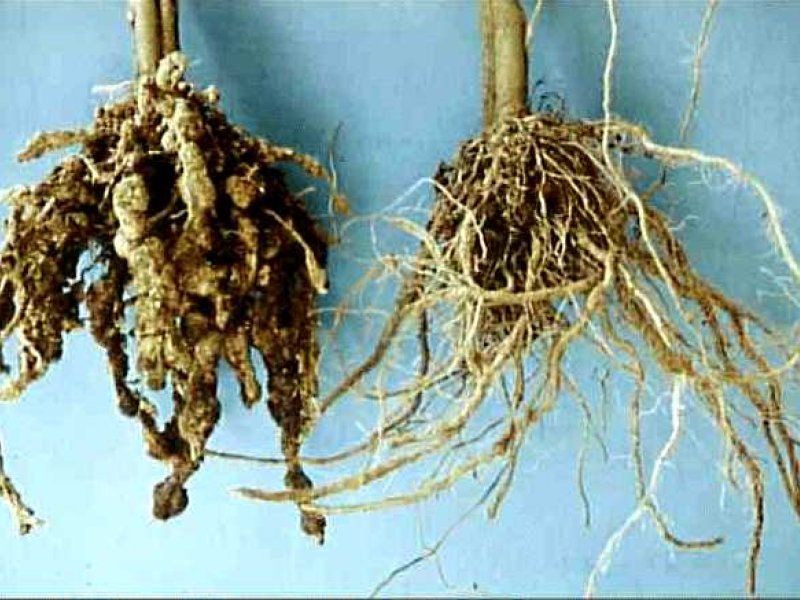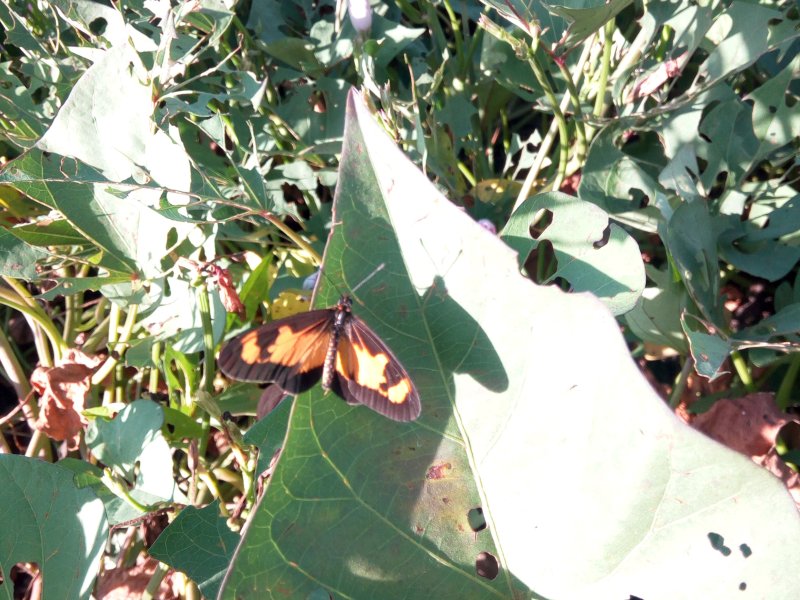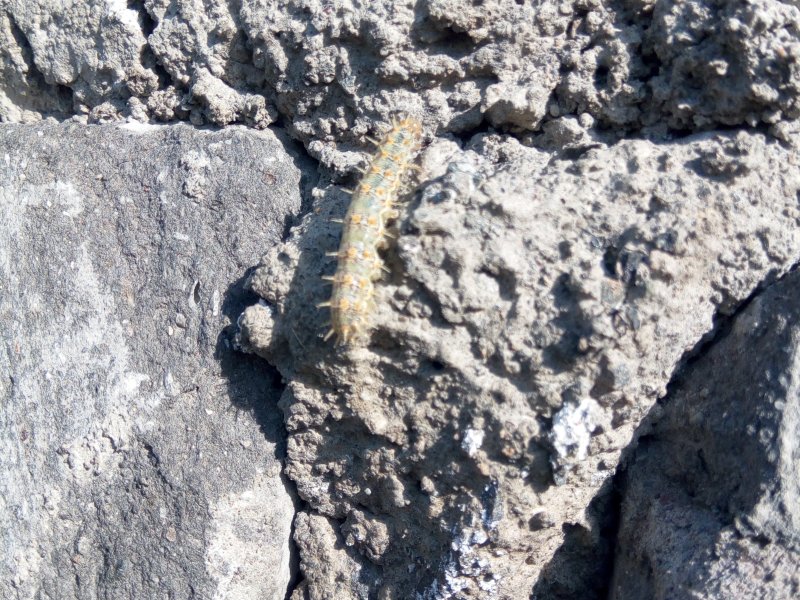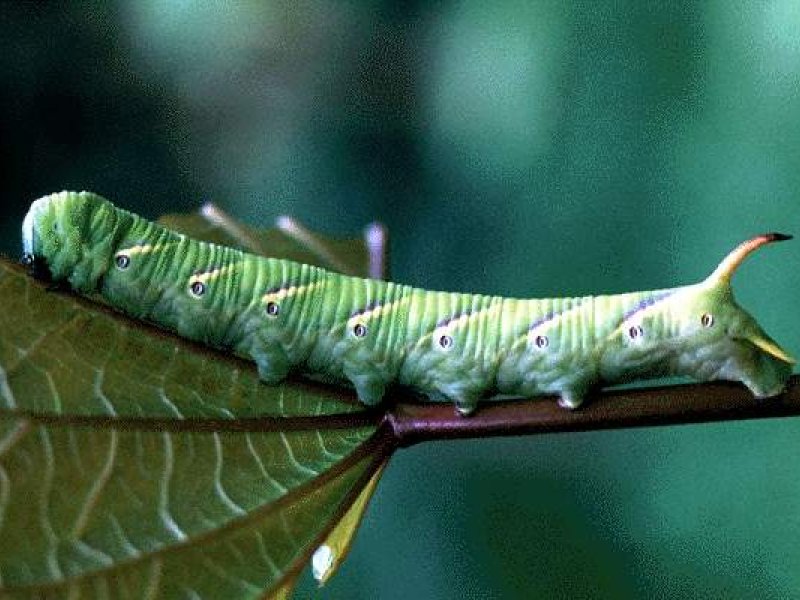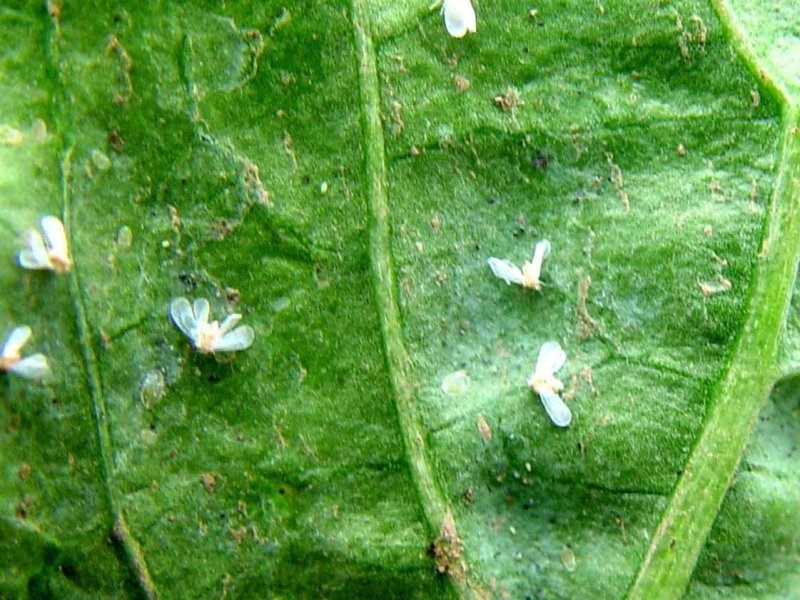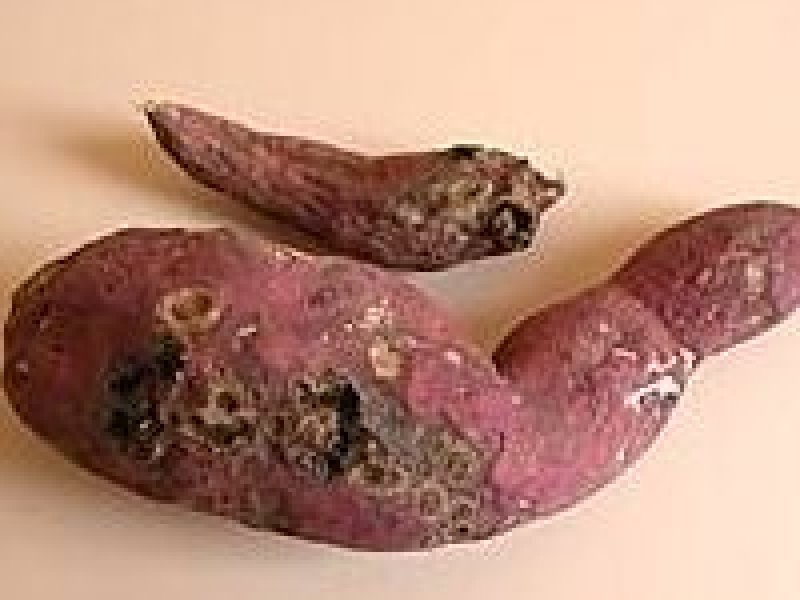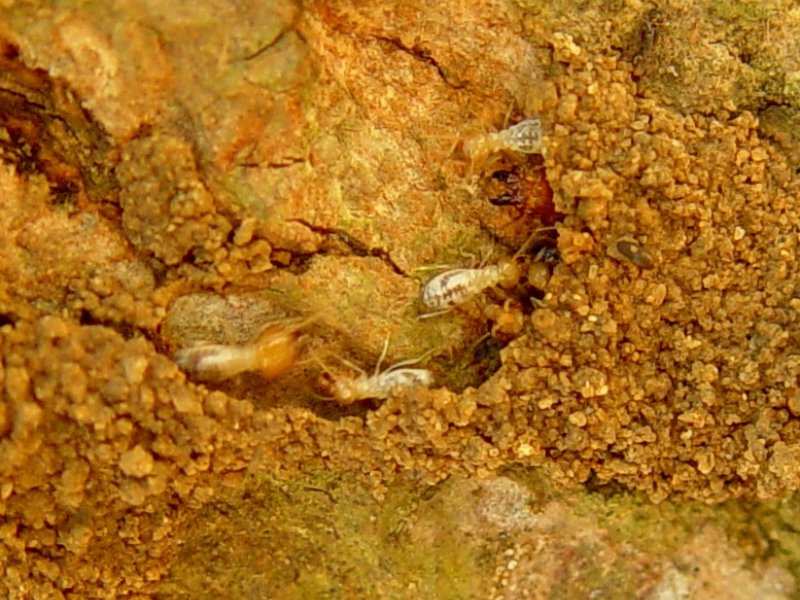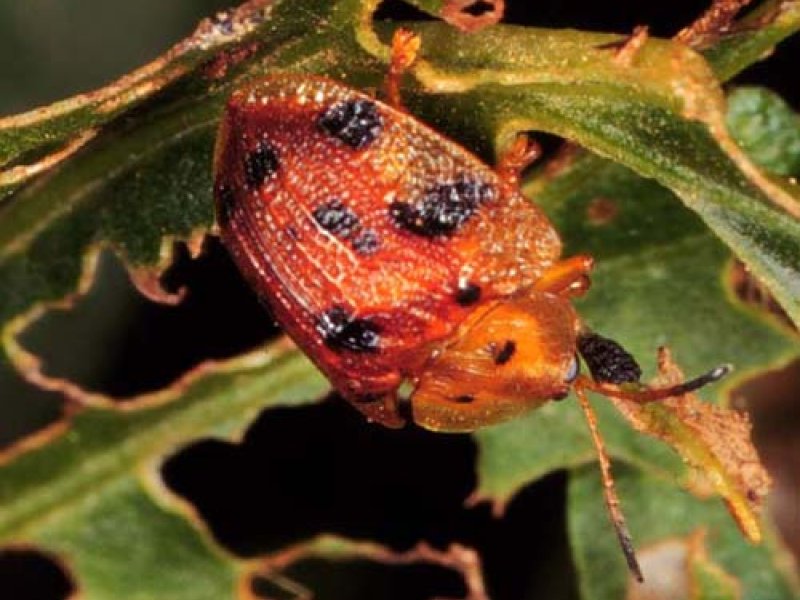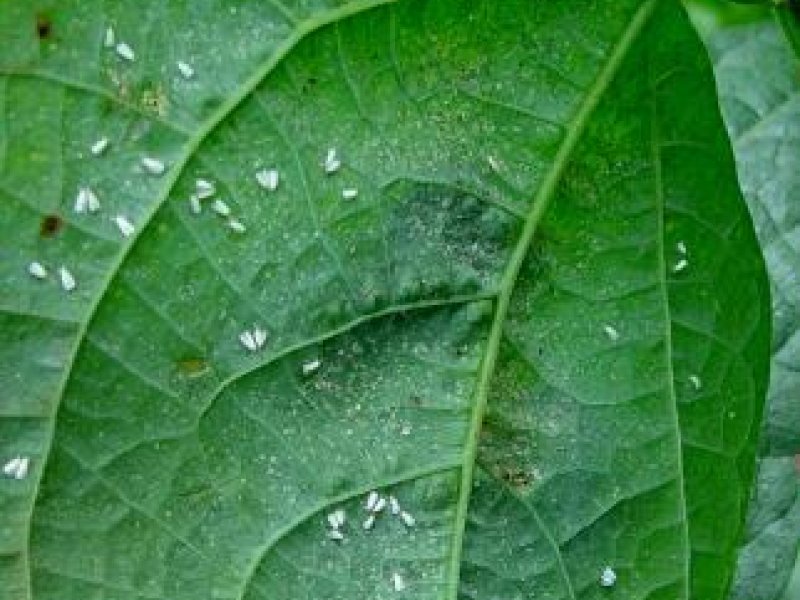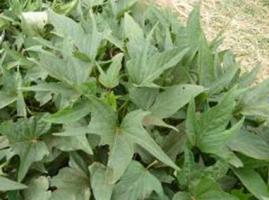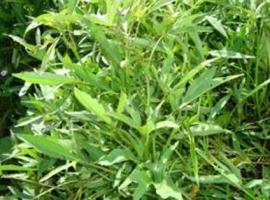|
Aphids (Aphis gossypii and other species) Aphids suck sap from leaves and stems. They may cause considerable damage during periods of water stress. Aphids are vectors of virus diseases. |
|
|
What to do:
For more information on Neem click here. For more information on soap sprays click here. |
|
Beet armyworm (Spodoptera exigua) Armyworms may damage sweet potatoes. Young caterpillars scrape sweet potato leaves, while the older caterpillars feed producing large irregular holes and may leave only the veins. Mature caterpillars measure up to 4 cm long and are generally black, heads faintly mottled with dark brown spots and with light yellow stripes at their backs (IRRI, 2001).
Predatory bugs, carabid beetles, spiders and wasps attack the caterpillars, and many parasitic wasps are also known to attack armyworms. Fungal diseases have been observed infecting caterpillars in the field. |
|
|
What to do:
|
|
Black rot (Ceratocystis fimbriata) The disease is caused by the fungus Ceratocystis fimbriata. Dark circular spots appear on infected roots. These spots can expand to cover much of the sweet potato. Small black fungal fruiting bodies (perithecia) develop and are visible at the centre of the spots. The diseased tissue is darkened and bitter in taste. On young sprouts black spots develop eventually encircling the plant causing dwarfing, yellowing of the foliage and finally death. The fungus survives in the soil in diseased plant debris and also in diseased stored roots. The disease is favoured by temperatures near 250C and moist soil conditions. In storage, decay progresses most rapidly in moist conditions at temperatures of 14 to 270C. |
|
|
What to do:
|
|
Diplodia black storage rot (Botryodiplodia theobromae (Diplodia tubericola)) The disease is caused by the fungus Botryodiplodia theobromae (Diplodia tubericola). It affects sweet potatoes in storage. The inner part of the infected edible root becomes black and brittle. Many tiny black fungal bodies (pycnidia) form just below the sweet potato skin giving the root a pimply appearance. Infection occurs through broken ends and abrasions on storage roots. Wet conditions favour disease spread and development. |
|
|
What to do:
|
|
Domestic and wild animals Domestic animals (e.g. pigs, cows and goats) and wild animals (e.g. wild pigs, porcupines, baboons, monkeys, elephants, hippos, guinea fowl) can cause serious damage to sweet potatoes. |
|
|
What to do:
|
|
Eriophyid mites (Aceria sp) They causes hairiness on sweet potato, a common problem in many parts of East and Southern Africa also known as "erinose". Eriophyid mites are tiny, much smaller than the spider mites (about 0.2 mm long) and look like a speck of dust. They are not visible with the naked eye. The mites feed in the buds and on young foliage of sweet potato plants, injecting growth substances into it, which induce the plant to produce a dense mat of hairs. As a result the stems, leaf petioles, buds and undersides of leaves become covered with a dense layer of white hairs. The leaves and plants are also generally slightly stunted; the leaves and stems thickened, and the plants yield poorly.
Occasionally, whole crops are affected but often the symptoms affect just one or a patch of plants, and often only particular varieties. The mites invade crops by being blown like dust particles in the wind. |
|
|
What to do:
|
|
Fusarium wilt (Fusarium oxysporum f. sp. batatas) It is caused by the fungus Fusarium oxysporum f. sp. batatas. Initial symptoms on sweet potato are yellowing of the leaves. Leaves later wilt and fall off, stunting results and eventually death of the plant. Death of the stem vascular bundles occurs with brown to purple coloured when split; this may be accompanied by cracking of the stem. The vines may turn tan to light brown. Diseased plants may manage to produce storage roots, but these usually have some discoloured, infected vascular tissues. Rot may follow in storage or the disease may be transmitted to the next crop by infected cuttings. Dying vines often have pinkish fungal growth. |
|
|
What to do:
|
|
Mild mottle virus It is caused by a potyvirus (sweet potato virus B/ sweet potato virus T/ sweet potato ipomovirus). The virus is transmitted by whiteflies (Bemisia tabaci). The virus has a wide host range including tomato, tobacco and ornamental species. Symptoms of the disease include leaf mottling and plant stunting. The wishbone flower (Torenia fournieri) is a potential wild reservoir host in East Africa. |
|
|
What to do:
|
|
Millipedes Apart from insects other pests reported to cause damage to sweet potatoes are millipedes. They are also known as "thousand-legged worms" or "Mombasa train". They have many legs (30-400) with a hard-shelled, round segmented body and are up to 30 cm long. They are brown to blackish brown in colour. They move slowly and curl-up when disturbed. Millipedes lay eggs single or in clusters of 20-100 in the soil. They live in moist soil and congregate around the plants in soil that is rich in organic content. They dry out easily and die. Thus, they seek wet places, such as compost piles, leaves and other plant debris, to hide under during the day.
Millipedes have recently become important pests of sweet potato in some areas of East Africa. Infestation tends to be severe at the beginning of the long rainy season often causing farmers to plant late. According to farmers in Uganda, millipedes generally do not affect the roots until 5 months after planting. They may be a problem when harvesting of sweet potato is delayed, especially if the roots are stored 'in-ground on the plants' during the dry season and harvesting is done at the first rains of the following growing season. Millipedes maybe a problem in nurseries located in shady sites (for example under a tree), especially if the nurseries are used for long time. |
|
|
What to do:
|
|
Rats Rats and mole rats occasionally feed on sweet potato storage roots either by digging through the ridges or accessing the exposed roots. They often spoil more roots than they actually eat. Rats and mice breed in burrows, destruction of these burrows can help reduce populations. Rodents like to hide in vegetation and rubbish, as they do not like crossing open spaces where they may be seen and exposed to predation, keeping the field and surrounding areas clean should reduce damage. |
|
|
What to do:
|
|
Root-knot nematodes (Meloidogyne spp.) The nematodes belong to Meloidogyne spp.. Symptoms consist of poor growth, yellowing of foliage and or wilting of plants during dry hot weather. Root swellings or galls develop on feeder roots. Harvested roots often are misshapen, cracked, and rotted on the surface. |
|
|
What to do:
|
|
Sweet potato butterfly (Acraea acerata) It is found in all sweet potato production areas in Eastern Africa, but is only considered an important pest in relatively dry areas. The adults are butterflies with orange wings with black margins. These butterflies are capable of flying distances of several kilometres. They lay small, pale yellow eggs in clusters on leaves. Caterpillars are greenish-black and are covered with short-branched spines. Fully-grown caterpillars are about 25 mm long. Caterpillars feed on leaves of sweet potato. Young caterpillars feed in groups on the upper leaf surface protected by a layer of webbing for the first two weeks.
Older caterpillars become solitary and nocturnal hiding on the ground during the day. They eat the whole leaf leaving only the midribs. Heavy attack may result on complete defoliation. Mature caterpillars crawl up supports such as tall grasses, leaves or walls near the sweet potato field in order to find a site to pupate in vertical position. The pupae are yellowish and hang singly on their support. The total lifecycle takes 27-50 days. Caterpillars are attacked by predatory ants, ladybird beetles, lacewings and dragonflies. The fungus Beauveria bassiana has been observed on caterpillars in the field during the rainy season. |
|
|
What to do:
|
|
Sweet potato hornworm or the hawk moth (Agrius convolvuli) Adults are large grey hawk moths with black lines on the wings and broad incomplete pink bands on the abdomen. The female lays small spherical greenish eggs singly on either surface of the leaves. Caterpillars have a conspicuous posterior horn. They are variable in colour, usually greenish or brownish. Fully-grown caterpillars are large (up to 9.5 cm long and 1.4 cm broad). They pupate in the soil. Caterpillars feed on leaves, causing irregular holes. They may eat the entire leaf, leaving only the petiole. Insect frass can often be found near the infested plant part. One large caterpillar can defoliate a plant on its own. When older caterpillars are present in large numbers they can defoliate a field overnight. Yield losses can occur if heavy defoliation takes place when the crop is young. But, if the young plants are healthy and growing well, they can recover. However, damage to the leaves may delay harvest, increasing the likelihood of attack by the sweet potato weevil.
|
|
|
What to do:
|
|
Sweet potato moth (Omphisa anastomasalis) The sweet potato moth is a minor pest in West Africa. Damage to sweet potato plants results from the caterpillar boring into the main stem leading to the roots. Vines with severe tunnelling show weak growth and poor foliage development; this foliage later yellows and wilts. The distal part of the vine above the damage site often dies. Such plants show poor storage root formation. In some cases caterpillars may bore directly into storage roots. This moth is a pest in Asia, but its status in East Africa is unknown. |
|
|
What to do:
|
|
Sweet potato virus complex This disease is caused by a combination of sweet potato feathery mottle virus (SPFMV) and sweet potato chlorotic stunt virus (SPCSV). Symptoms include severe stunting of plants, the production of small distorted leaves, excessive branching, yellowing of vines and dark, brown to blackish corky spots in the roots. SPFMV is a potyvirus transmitted by aphids in a non-persistent manner whereas SPCSV is a crinivirus transmitted in a semi-persistent manner by the whitefly Bemisia tabaci. |
|
|
What to do:
For information on how to control Aphids click here. For information on how to control whiteflies click here. |
|
Sweet potato weevil (Alcidodes erronus) The sweet potato weevil is the most destructive insect pest of sweet potato in the tropics and subtropics. No resistant source is available. Farmer experience: In Kilifi, Kenya, farmers create planting mounds or ridges incorporating a good amount of fresh leaves of Lantana camara before planting sweet potatoes. This improves soil organic matter and at the same time serves as a repellent of the sweet potato weevil, thus improving both yield and quality of harvested tubers. The superior quality of sweet potatoes grown using Lantana leaves have been confirmed by Ministry of Agriculture staff in the area. |
|
|
What to do:
|
|
Termites (Coptotermes formosanus) Occasionally termites can be a problem by attacking the seed pieces or the roots and stems of established plants. Yield losses can be very high. In Sudan losses of 18 % have been recorded and in Central Africa losses of 5-10 % are common. In Nigeria plant germination failure of up to 28 % has been reported. The most common damage to sugar cane is the destruction of the planting material (setts). |
|
|
What to do:
|
|
Tortoiseshell beetles (Aspidomorpha spp.) Adults are broadly oval and shield-like, 6-8 mm long, and may be brightly coloured. They lay eggs singly or in batches on the underside of sweet potato leaves; sometimes the eggs are covered by a papery layer. The larvae are oval, flattened and spiny. Some species of tortoiseshell beetle larvae hold their tails up over their back, usually with excreta and previous cast skins. The pupa is less spiny than the larva, and is fixed to the leaf.
Both larvae and adults feed on leaves. The young larvae scrape on the upper surface of the leaves leaving the lower surface intact, while older larvae and adults eat large round holes in the leaves. Severe attacks can sometimes skeletonise the leaves and peel the stems. The damage on leaves is conspicuous, but generally is not of economic importance. |
|
|
What to do:
|
|
Whiteflies (Bemisia tabaci) Whiteflies feed on the lower leaf surface. Direct damage by adults and nymphs sucking sap from the plant, is generally not economically important. However, high numbers of whiteflies may affect plant development, particularly during period of water stress and drought. They are more damaging as vector of virus diseases. |
|
|
What to do:
|
Geographical Distribution in Africa
Geographical distribution of Sweet Potato in Africa. Updated on 4 July 2019. Source FAOSTAT
General Information and Agronomic Aspects
Sweet potatoes are perennial vines, with one main season. It is widely grown throughout East Africa on a small scale mainly in subsistence farming and currently gaining popularity again along with other indigenous foods. The roots are eaten either boiled or roasted alone or with other foods such as milk, porridge, soups or meat. Young leaves are used as vegetable. The sweet potato vines are a useful and nutritious fodder crop, especially in the dry season. Some varieties are especially suited for this, producing abundant tops.
Among the great diversity of cultivars grown, 2 types are commonly recognised. The staple types, grown throughout the tropics, are usually white, red or purple, although yellow-fleshed types are becoming popular in Africa and Asia. The orange-fleshed types, typically have a higher sugar and vitamin A and lower dry matter content. Nutritionists in East Africa are promoting the use of yellow fleshed sweet potato varieties to combat wide spread vitamin A deficiency which decreases children's resistance to infectious diseases, contributing to infant mortality. The young leafy shoots, which are eaten as a green vegetable in some countries, are high in protein (approximately 20% of dry weight), and are also a good source of b-carotene, thiamine (vitamin B1), riboflavin (B2), folic acid and ascorbic acid (Villareal et al., 1985; Woolfe, 1992).
Nutritive Value per 100 g of edible Portion
| Raw or Cooked Sweet Potato | Food Energy (Calories / %Daily Value*) |
Carbohydrates (g / %DV) |
Fat (g / %DV) |
Protein (g / %DV) |
Calcium (g / %DV) |
Phosphorus (mg / %DV) |
Iron (mg / %DV) |
Potassium (mg / %DV) |
Vitamin A (I.U) |
Vitamin C (I.U) |
Vitamin B 6 (I.U) |
Vitamin B 12 (I.U) |
Thiamine (mg / %DV) |
Riboflavin (mg / %DV) |
Ash (g / %DV) |
| Sweet Potato baked in skin | 90.0 / 5% | 20.7 / 7% | 0.2 / 0% | 2.0 / 4% | 38.0 / 4% | 54.0 / 5% | 0.7 / 4% | 475 / 14% | 19217 IU / 384% | 19.6 / 33% | 0.3 / 14% | 0.0 / 0% | 0.1 / 7% | 0.1 / 6% | 1.3 |
| Sweet Potato cooked without skin | 76.0 / 4% | 17.7 / 6% | 0.1 / 0% | 1.4 / 3% | 27.0 / 3% | 32.0 / 3% | 0.7 / 4% | 230.0 / 7% | 15741 IU / 315% | 12.8 / 21% | 0.2 / 8% | 0.0 / 0% | 0.1 / 4% | 0.0 / 3% | 0.6 |
*Percent Daily Values (DV) are based on a 2000 calorie diet. Your daily values may be higher or lower, depending on your calorie needs.
Sweet potato is grown between latitudes 48°N and 40°S. At the equator it is grown at altitudes ranging from sea-level to 3000 m. Its growth is maximum at temperatures above 25°C; when temperatures fall below 12°C or exceed 35°C, growth is retarded.
Sweet potato is a sun-loving crop; however, it can tolerate a 30-50% reduction of full solar radiation. It grows best with a well-distributed annual rainfall of 600-1600 mm during the growing season. Dry weather favours the formation and development of storage roots. Sweet potato is relatively drought tolerant, however, it cannot withstand long periods of drought; the yield is considerably reduced if drought occurs about the time of planting or root initiation.
Maintaining soil organic matter is probably the most important management practice for managing water supply in rain-fed crops. Organic matter incorporated into the soil will help it to hold more water and remain moist for longer. Plant mulches applied to the surface of the soil also help to reduce surface evaporation and keep the soil temperature even. They also prevent soil crusting and improve infiltration when it rains. Weeding is also important, as weeds compete with the crop for water and accelerate soil drying. Uprooted weeds can be left on the soil as mulch.
Where irrigation is available, a number of factors should be considered in irrigation management:
- The aim is to keep the soil moisture conditions as constant as possible. In general, more frequent, light irrigations are preferred to larger water applications.
- Sufficient water should be applied to wet the root zone, without causing deep drainage or run-off. Apart from being wasteful of water, over watering can cause considerable loss of soil nutrients (leaching) while contaminating the groundwater and streams with the nutrients, which may be directly toxic to people or promote algal growth and eutrofication.Light-textured (sandy) soils will require more frequent irrigation than soils with high clay or organic matter content.
- Light-textured soils will also require less water to wet them through, and are more prone to leaching and run-off losses.
- The crop's water needs will be much higher in clear, hot and/or windy weather than in still, overcast weather.microorganisms.
After cultivation, the land is usually prepared into ridges. Mounds are preferred by farmers working entirely with hand tools. In some areas, broad raised beds are used. On deep, well-drained soil, planting may be done on flat fields.
Ridges should be oriented along contours on sloping land, to maximise rain water infiltration and minimise erosion. Ridges are typically about 30-45 cm high, but may be higher in wet areas to maximise soil drainage. They are usually between 90 and 120 cm apart.
Propagation and planting
If there is no critical dry season, sweet potato can be planted at any time. In regions with a critical dry season, planting early in the rainy season is the best. It is usually planted towards the end of the rainy season if this is long and very wet.
Sweet potato planting material is either obtained from vine cuttings, the most common source, or from storage roots.
Use of stem cuttings:
Farmers obtain cuttings from an established crop before or just after the harvest of storage roots. The cuttings are either used to establish a maintenance field, or directly for planting the next sweet potato crop. Below are some factors affecting yield, when using stem cuttings:
- Care should be taken to select 'clean' planting material. This means choosing cuttings that are free of insects, soil, and any symptoms of viruses or fungal diseases.
- Generally the apical (tip) portion of the vine is better than the middle or basal portions. This portion is less likely to carry sweetpotato weevils and fungal pathogens, and has been found to establish faster than other portions. For cultivars with long vines, the second or third cut is acceptable. Sometimes, the second cutting is better than the tip portion, if vine growth has been so fast that the stem has not matured in the apical portion.
- Length of cutting is less important than the number of nodes. Typical size is 20-40 cm, with 5-8 nodes. The conditions of the field may influence the relationship between cutting length and crop development. Farmers should experiment to decide what length is best under their conditions.
- Usually one-third to two-thirds of the cutting is buried. A minimum of 2-3 nodes, but up to about 8 nodes, is placed under the soil.
- The delay between cutting and planting may affect yield depending on the storage conditions for the cuttings. Storing cuttings for one to two days in humid conditions may be beneficial, promoting rooting at the nodes. Longer storage may adversely affect establishment by exhaustion of the cuttings' energy reserves. To minimise losses, leaves should be stripped from the lower portion of the cutting, and bundles of cuttings wrapped in a wet cloth or sack and kept in a cool, shady place away from wind. If roots develop during storage, they should be planted carefully to minimise damage to the roots.
- If planting material is to be maintained in a multiplication plot before planting of the next crop, it is recommended that plant cuttings be planted at approximately 15 x 20 cm spacing. New growth may be ready for cutting after 45 days.
Use of storage roots:
Storage roots are used when there are insufficient stem cuttings available, or when the level of pest and disease infestation is high so that few healthy vines are left. They may also be used in highly mechanised production, as the sprouts can be harvested mechanically from the seedbed. Healthy storage roots should be selected from plants that produced high yield. The roots are planted densely in a seedbed located away from other sweetpotato crops. Roots are covered with about 3 cm of soil, and the bed covered with straw to help retain moisture. When the sprouts have grown long enough, they are cut near their base and planted directly in the field. To maximise the number of cuttings, remove the tips of the sprouts when they are about 20 cm long to promote branching.
Rapid seed multiplication:
When large amounts of cuttings are needed, rapid multiplication may be done. Although the merit of this practice has not been fully acknowledged by sweet potato growers, it can be the easiest way to produce large amount of planting materials. This method involves the following steps:
- Cuttings of about 30 cm are taken from either established plants or sprouted storage roots. These are then cut into single node cuttings, with the leaf attached. The tip of the vine is discarded.
- A seedbed is prepared with a mixture of loose, humus-rich soil and ash. The single-node cuttings are planted at a high density, with the stem section buried and the leaf upright.
- The seedbed is regularly watered and is prevented from drying especially during the first week of establishment.
- After about 2 weeks, when the seedlings have developed enough roots, they should be transplanted into the field. They should be removed from the seedbed with care to avoid damaging the roots. Transplanting should be done in the late afternoon to avoid excessive evaporation and wilting.
Degeneration of planting material
When sweet potato is vegetatively propagated for a number of generations, yield decline is often observed. This is usually due to a build-up of viruses, many of which show no obvious symptoms. This often gives the impression that a new variety (carrying few viruses) yields much better than traditional varieties, when in fact it may be no better after a year or two when viruses have accumulated.
Viruses can be removed by heat treatment and meristem culture (from research institutions). This process usually results in a yield increase from 20 to 200%, of both vines and roots, depending on the severity of the original virus infestation. The higher yield may be maintained for several years in the field, before the virus load has built up again.
Planting method
After ridges or mounds are formed, the sweetpotato cuttings are planted by burying the lower part in the top of the ridge or mound. A hole may be made with a stick or by hand, and the soil gently pressed around the inserted cutting. The stem is usually placed at an angle. Some workers claim that cuttings oriented across the ridge yield better than those oriented along the ridge. In ridge planting systems, ridge spacing is typically 90-120 cm, and in row spacing is 20-30 cm (3-5 plants per metre). Generally, a higher plant density results in lower yield per plant but higher yield per hectare. Close spacing is used with short growing seasons, and wider spacing may be preferred where the market prefers larger storage roots.
For mounds, the size and spacing of the mounds depends on soil conditions. They may be 75-200 cm apart, and may be planted with several cuttings per mound.
Some farmers plant 2 cuttings at each mound, but there is little evidence that this is advantageous. It has been reported that single cuttings produce a higher proportion of large storage roots.
Varieties
Farmers plant a mixture of varieties, mostly based on yield, performance, maturity, culinary values and tolerance to pests. This strategy reduces the risk of failure since the varieties have different useful characteristics. Sweet potato varieties planted in north-eastern Uganda are presented in the table below.
Sweet potato varieties grown in North-Eastern Uganda
| Variety | Characteristic |
| "Osukut" | Early maturing, good yield, sweet, good marketability. |
| "Araka Red" | Early maturing, good yield, tolerant to Cylas spp. |
| "Araka White" | Early maturing, good yield. |
| "Lira Lira" | Early maturing, good yield. |
| "Ateseke" | Good yield. |
| "Igang Amalayan" | Early maturing, good yield. |
| "Latest" | Early maturing, good yield, sweet. |
| "Osapat" | Good yield. |
| "Ekampala" | Good yield. |
| "Tedo Oloo Keren" | Good yield, tolerant to Cylas spp. |
| "Odupa" | Tolerant to Cylas spp. |
Source: Ebregt et al, 2004.
Sweet potato varieties grown in Kenya
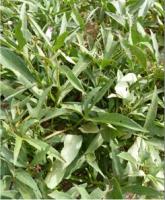 |
| SPK 004 leaves |
|
© A. Bruntse, Infonet
|
/
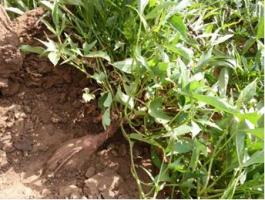 |
| SPK 004 tuber |
|
© A. Bruntse, Infonet
|
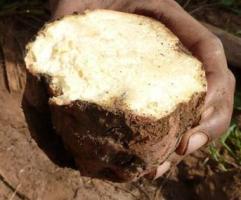 |
| Cross section of SPK 004 tuber |
|
© A. Bruntse, Infonet
|
Suitable for most areas in the country. Planting material available at KARI Katumani. Red skin color, cream flesh. Popular high yielding variety
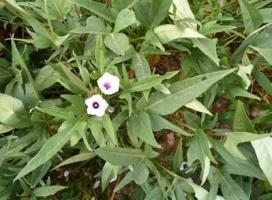 |
| "KEMBO 10" leaves and flower |
|
© A. Bruntse, Infonet
|
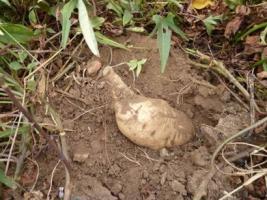 |
| "KEMBO 10" tuber |
|
© A. Bruntse, Infonet
|
Suitable for most areas in the country. Planting material available at KARI Katumani. White skin color, white flesh.
Popular high yielding variety
|
"SPK 013" |
Recommended for the western zone including the Lake basin |
| "Kemb 20" | |
| "Kemb 23" | Suitable for Central and coastal lowlands |
| "KSP20" | Good performance in dry areas |
| "KSP11" | Good performance in dry areas |
| "Simama" | |
| "Japaneese" | |
| "Mugande" | |
| "Muibai" ("Kemb 36") | |
| "NASPOT 1 " | Popular variety in Ukambani, High dry matter content in tubers. Planting material available at KARI Katumani |
| "Ex-Diani" | Suitable for central and coastal lowlands |
| "Mafuta" | Best for foliage production. Good for all areas. |
| "CIP 420009" | Good performance in dry areas |
| "Mtwapa 8 " | Suitable for coastal and eastern lowland areas |
Attributes of some sweet potato varieties grown in Kenya
| Variety | Maturity (months) | Tuber yield (100 kg bags/acre) | Skin colour | Flesh colour |
| "Enaironi" | 3-4 | 65-70 | White | Orange |
| "Ex-Mukurweini " | 3 | 60-65 t/ha foliage | Fodder | Fodder |
| "Ex-Simba " | 3-4 | 70 | Red | White |
| "Kanchwere " | 6-7 | 40-50 | Red | Orange |
| "Kemb 10 " | 3-4 | 70 | White | Cream |
| "Kemb 20" | 4-5 | 75 | Red | White |
| "Kemb 23 " | 5-6 | 90 | White | Cream |
| "Kemb 36 " | 5-6 | 35 | Red | White |
| "KSP 20 " | 3-4 | 95 | Red | White |
| "KSP 47 " | 3-4 | 70 | Red | Light Orange |
| "KSP 72 " | 3-4 | 70 | Red | Light Orange |
| "KSP 84 " | 3-4 | 70 | Red | Orange |
| "KSP 154 " | 3-4 | 70 | Red | Orange |
|
"Musinya " 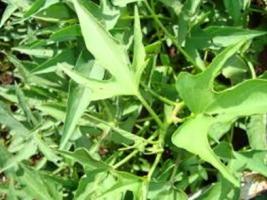 "Musinya " leaves
© N. Kinuthia, Infonet
|
3 | 90-95 t/ha foliage | Fodder | Fodder |
|
"NASPOT"
"NASPOT" leaves
© A. Bruntse, Infonet
|
3.5-4.5 | 80-90 | Light brown | Orange |
|
"SPK 004"
"SPK 004" leaves
© N. Kinuthia, Infonet
|
3-4 | 80 | Light brown | Orange |
| "Tainung " | 3-4 | 80-90 | Light brown | Orange |
Popular sweet potato varieties in South Western Kenya (KALRO Kisii)
| Variety | Tuber yield (100 kg bag/acre) |
| "Bungoma" | 40-50 |
| "Gikuyu" | 40-50 |
| "Kalam Nyerere " | 40-50 |
| "K117" | Vine yield 23 t/ha foliage |
| "Mugande " | 40-50 |
| "Mwavuli" | Vine yield 20 t/ha foliage |
"Namaswakhe"
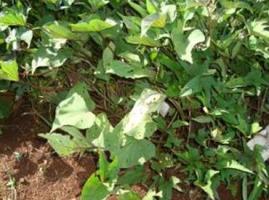 "Namaswakhe" leaves
© N. Kinuthia, Infonet
|
40-50 |
| "Nyakabondo" | 40-50 |
| "Nyakathuri" | 40-50 |
|
"Nyawo/Amina/Misambi" 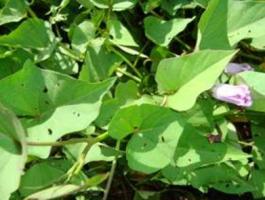 "Nyawo/Amina/Misambi" leaves and flower © N. Kinuthia, Infonet
|
40-50 |
|
"Odinga" 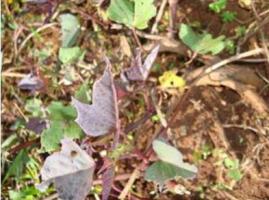 Odinga" leaves © N. Kinuthia, Infonet
|
40-50 |
| "Polista" | 40-50 |
Husbandry
Weed infestation during the first 2 months of growth poses a problem in stand development, and requires adequate control to ensure high yield. Thereafter, vigorous growth of the vines covers the ground effectively and smothers weeds. In the tropics, manual weeding is generally practised.
Sweet potato responds well to fertilisation, particularly if the land has been continuously cropped. However, fertiliser is seldom applied in the tropics. Manure or good compost should be incorporated to improve soil fertility. This is a common practice in smallholdings and traditional agriculture. Sweet potato is used in a wide variety of cropping systems around the world. Rotating sweet potato with other crops such as rice, legumes and maize is desirable to control diseases, pests and weeds.Intercropping sweet potato with other crops is very common in Africa.
Nutritional deficiencies can be determined using the guide provided in the website of the International Potato Center: http://keys.lucidcentral.org/keys/sweetpotato/
Harvesting
The harvesting period of sweet potato storage roots is not clearly defined; it varies with cultivar, cultural practices and climate. 'Progressive harvesting' (piece-meal harvesting) is common practice in tropical countries where sweet potatoes are grown for home consumption. It is generally recommended to harvest within 4 months to prevent weevil damage. In the tropics, manual harvesting using implements such as a stick, spade or hoe is practised.
| Sweet potato weevil (Alcidodes erronus) The sweet potato weevil is the most destructive insect pest of sweet potato in the tropics and subtropics. No resistant source is available. Farmer experience: In Kilifi, Kenya, farmers create planting mounds or ridges incorporating a good amount of fresh leaves of Lantana camara before planting sweet potatoes. This improves soil organic matter and at the same time serves as a repellent of the sweet potato weevil, thus improving both yield and quality of harvested tubers. The superior quality of sweet potatoes grown using Lantana leaves have been confirmed by Ministry of Agriculture staff in the area. What to do:
|
| Root-knot nematodes (Meloidogyne spp.) The nematodes belong to Meloidogyne spp.. Symptoms consist of poor growth, yellowing of foliage and or wilting of plants during dry hot weather. Root swellings or galls develop on feeder roots. Harvested roots often are misshapen, cracked, and rotted on the surface. What to do:
|
| Apart from insects other pests reported to cause damage to sweet potatoes are millipedes. They are also known as "thousand-legged worms" or "Mombasa train". They have many legs (30-400) with a hard-shelled, round segmented body and are up to 30 cm long. They are brown to blackish brown in colour. They move slowly and curl-up when disturbed. Millipedes lay eggs single or in clusters of 20-100 in the soil. They live in moist soil and congregate around the plants in soil that is rich in organic content. They dry out easily and die. Thus, they seek wet places, such as compost piles, leaves and other plant debris, to hide under during the day.
Millipedes have recently become important pests of sweet potato in some areas of East Africa. Infestation tends to be severe at the beginning of the long rainy season often causing farmers to plant late. According to farmers in Uganda, millipedes generally do not affect the roots until 5 months after planting. They may be a problem when harvesting of sweet potato is delayed, especially if the roots are stored 'in-ground on the plants' during the dry season and harvesting is done at the first rains of the following growing season. Millipedes maybe a problem in nurseries located in shady sites (for example under a tree), especially if the nurseries are used for long time. What to do:
|
| Domestic animals (e.g. pigs, cows and goats) and wild animals (e.g. wild pigs, porcupines, baboons, monkeys, elephants, hippos, guinea fowl) can cause serious damage to sweet potatoes. What to do:
|
| Rats and mole rats occasionally feed on sweet potato storage roots either by digging through the ridges or accessing the exposed roots. They often spoil more roots than they actually eat. Rats and mice breed in burrows, destruction of these burrows can help reduce populations. Rodents like to hide in vegetation and rubbish, as they do not like crossing open spaces where they may be seen and exposed to predation, keeping the field and surrounding areas clean should reduce damage. What to do:
|
| Sweet potato butterfly (Acraea acerata) It is found in all sweet potato production areas in Eastern Africa, but is only considered an important pest in relatively dry areas. The adults are butterflies with orange wings with black margins. These butterflies are capable of flying distances of several kilometres. They lay small, pale yellow eggs in clusters on leaves. Caterpillars are greenish-black and are covered with short-branched spines. Fully-grown caterpillars are about 25 mm long. Caterpillars feed on leaves of sweet potato. Young caterpillars feed in groups on the upper leaf surface protected by a layer of webbing for the first two weeks.
Older caterpillars become solitary and nocturnal hiding on the ground during the day. They eat the whole leaf leaving only the midribs. Heavy attack may result on complete defoliation. Mature caterpillars crawl up supports such as tall grasses, leaves or walls near the sweet potato field in order to find a site to pupate in vertical position. The pupae are yellowish and hang singly on their support. The total lifecycle takes 27-50 days. Caterpillars are attacked by predatory ants, ladybird beetles, lacewings and dragonflies. The fungus Beauveria bassiana has been observed on caterpillars in the field during the rainy season. What to do:
|
| Beet armyworm (Spodoptera exigua) Armyworms may damage sweet potatoes. Young caterpillars scrape sweet potato leaves, while the older caterpillars feed producing large irregular holes and may leave only the veins. Mature caterpillars measure up to 4 cm long and are generally black, heads faintly mottled with dark brown spots and with light yellow stripes at their backs (IRRI, 2001).
Predatory bugs, carabid beetles, spiders and wasps attack the caterpillars, and many parasitic wasps are also known to attack armyworms. Fungal diseases have been observed infecting caterpillars in the field. What to do:
|
| Sweet potato hornworm or the hawk moth (Agrius convolvuli) Adults are large grey hawk moths with black lines on the wings and broad incomplete pink bands on the abdomen. The female lays small spherical greenish eggs singly on either surface of the leaves. Caterpillars have a conspicuous posterior horn. They are variable in colour, usually greenish or brownish. Fully-grown caterpillars are large (up to 9.5 cm long and 1.4 cm broad). They pupate in the soil. Caterpillars feed on leaves, causing irregular holes. They may eat the entire leaf, leaving only the petiole. Insect frass can often be found near the infested plant part. One large caterpillar can defoliate a plant on its own. When older caterpillars are present in large numbers they can defoliate a field overnight. Yield losses can occur if heavy defoliation takes place when the crop is young. But, if the young plants are healthy and growing well, they can recover. However, damage to the leaves may delay harvest, increasing the likelihood of attack by the sweet potato weevil.
What to do:
|
| Tortoiseshell beetles (Aspidomorpha spp.) Adults are broadly oval and shield-like, 6-8 mm long, and may be brightly coloured. They lay eggs singly or in batches on the underside of sweet potato leaves; sometimes the eggs are covered by a papery layer. The larvae are oval, flattened and spiny. Some species of tortoiseshell beetle larvae hold their tails up over their back, usually with excreta and previous cast skins. The pupa is less spiny than the larva, and is fixed to the leaf.
Both larvae and adults feed on leaves. The young larvae scrape on the upper surface of the leaves leaving the lower surface intact, while older larvae and adults eat large round holes in the leaves. Severe attacks can sometimes skeletonise the leaves and peel the stems. The damage on leaves is conspicuous, but generally is not of economic importance. What to do:
|
| Sweet potato moth (Omphisa anastomasalis) The sweet potato moth is a minor pest in West Africa. Damage to sweet potato plants results from the caterpillar boring into the main stem leading to the roots. Vines with severe tunnelling show weak growth and poor foliage development; this foliage later yellows and wilts. The distal part of the vine above the damage site often dies. Such plants show poor storage root formation. In some cases caterpillars may bore directly into storage roots. This moth is a pest in Asia, but its status in East Africa is unknown. What to do:
|
| Whiteflies feed on the lower leaf surface. Direct damage by adults and nymphs sucking sap from the plant, is generally not economically important. However, high numbers of whiteflies may affect plant development, particularly during period of water stress and drought. They are more damaging as vector of virus diseases. What to do:
|
| Aphids (Aphis gossypii and other species) Aphids suck sap from leaves and stems. They may cause considerable damage during periods of water stress. Aphids are vectors of virus diseases. What to do:
For more information on Neem click here. For more information on soap sprays click here. |
| They causes hairiness on sweet potato, a common problem in many parts of East and Southern Africa also known as "erinose". Eriophyid mites are tiny, much smaller than the spider mites (about 0.2 mm long) and look like a speck of dust. They are not visible with the naked eye. The mites feed in the buds and on young foliage of sweet potato plants, injecting growth substances into it, which induce the plant to produce a dense mat of hairs. As a result the stems, leaf petioles, buds and undersides of leaves become covered with a dense layer of white hairs. The leaves and plants are also generally slightly stunted; the leaves and stems thickened, and the plants yield poorly.
Occasionally, whole crops are affected but often the symptoms affect just one or a patch of plants, and often only particular varieties. The mites invade crops by being blown like dust particles in the wind. What to do:
|
| Termites (Coptotermes formosanus) Occasionally termites can be a problem by attacking the seed pieces or the roots and stems of established plants. Yield losses can be very high. In Sudan losses of 18 % have been recorded and in Central Africa losses of 5-10 % are common. In Nigeria plant germination failure of up to 28 % has been reported. The most common damage to sugar cane is the destruction of the planting material (setts). What to do:
|
| Black rot (Ceratocystis fimbriata) The disease is caused by the fungus Ceratocystis fimbriata. Dark circular spots appear on infected roots. These spots can expand to cover much of the sweet potato. Small black fungal fruiting bodies (perithecia) develop and are visible at the centre of the spots. The diseased tissue is darkened and bitter in taste. On young sprouts black spots develop eventually encircling the plant causing dwarfing, yellowing of the foliage and finally death. The fungus survives in the soil in diseased plant debris and also in diseased stored roots. The disease is favoured by temperatures near 250C and moist soil conditions. In storage, decay progresses most rapidly in moist conditions at temperatures of 14 to 270C. What to do:
|
| Diplodia black storage rot (Botryodiplodia theobromae (Diplodia tubericola)) The disease is caused by the fungus Botryodiplodia theobromae (Diplodia tubericola). It affects sweet potatoes in storage. The inner part of the infected edible root becomes black and brittle. Many tiny black fungal bodies (pycnidia) form just below the sweet potato skin giving the root a pimply appearance. Infection occurs through broken ends and abrasions on storage roots. Wet conditions favour disease spread and development. What to do:
|
| Fusarium wilt (Fusarium oxysporum f. sp. batatas) It is caused by the fungus Fusarium oxysporum f. sp. batatas. Initial symptoms on sweet potato are yellowing of the leaves. Leaves later wilt and fall off, stunting results and eventually death of the plant. Death of the stem vascular bundles occurs with brown to purple coloured when split; this may be accompanied by cracking of the stem. The vines may turn tan to light brown. Diseased plants may manage to produce storage roots, but these usually have some discoloured, infected vascular tissues. Rot may follow in storage or the disease may be transmitted to the next crop by infected cuttings. Dying vines often have pinkish fungal growth. What to do:
|
| It is caused by a potyvirus (sweet potato virus B/ sweet potato virus T/ sweet potato ipomovirus). The virus is transmitted by whiteflies (Bemisia tabaci). The virus has a wide host range including tomato, tobacco and ornamental species. Symptoms of the disease include leaf mottling and plant stunting. The wishbone flower (Torenia fournieri) is a potential wild reservoir host in East Africa. What to do:
|
| This disease is caused by a combination of sweet potato feathery mottle virus (SPFMV) and sweet potato chlorotic stunt virus (SPCSV). Symptoms include severe stunting of plants, the production of small distorted leaves, excessive branching, yellowing of vines and dark, brown to blackish corky spots in the roots. SPFMV is a potyvirus transmitted by aphids in a non-persistent manner whereas SPCSV is a crinivirus transmitted in a semi-persistent manner by the whitefly Bemisia tabaci. What to do:
For information on how to control Aphids click here. For information on how to control whiteflies click here. |
Information Source Links
- AVRDC International Cooperator's Factsheet on Sweet Potato Vine Borer: www.avrdc.org
- Agricultural Information Centre, Nairobi, Kenya (2002). Field Crops Technical Handbook
- Blay, E., Cudjoe, A. R. and Braun, M. (eds).(2000). Handbook of crop protection recommendations in Ghana: An IPM approach. Vol. 3: Root and Tuber Crops, Plantains.Published byPlant Protection and Regulatory Services Directorate (PPRSD). with support of the German Development Cooperation (GTZ). ISBN: 9988-8025-6-0.
- CAB International (2005). Crop Protection Compendium, 2005 Edition. Wallingford, UK
- CIP website: www.cipotato.org
- CIP. Manual for Sweet potato Integrated Production and Pest Management Farmer Field Schools in Sub-Saharan Africa. The VITAA Partnership. Last Updated June 16, 2004. www.sweetpotatoknowledge.org
- Dunguni FFS (Farmer Field School), Kilifi, Kenya
- Ebregt, E., Struik, P.C., Abidin, P.E., Odongo, B. (2004). Farmers' information on sweet potato production and millipede infestation in North-eastern Uganda. II. Pest incidence and indigenous control strategies. NJAS - Wageningen Journal of Life Sciences 52: 69-84. www.library.wur.nl
- Hill, D. (1983). Agricultural insect pests of the tropics and their control. 2nd edition. Cambridge University Press. ISBN: 0-521-24638-5.
- Nutrition Data www.nutritiondata.com.
- Smit, N.E.J.M. (1997). Integrated pest management for sweet potato in Eastern Africa. PhD thesis Wageningen University, Wageningen, 151 pp.
- Wangige Organic Farmers Self Help group, Wangige, Central province, Kenya.
- Youdeowei, A. (2002). Integrated Pest Management Practices for the Production of Root and Tubers and Plantains. Integrated Pest Management Extension Guide 3. Ministry of Food and Agriculture (MOFA) Plant Protection and Regulatory Services Directorate (PPRSD), Ghana, with German Development Cooperation (GTZ). ISBN: 9988-0-1087-7.

